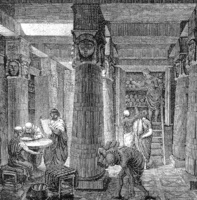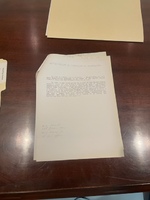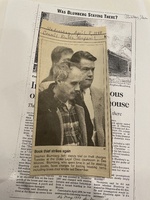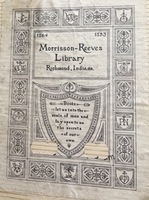Blumberg
Item set
- Title
- Blumberg
Items
-
 Library of Alexandria Imaginative drawing of the Library of Alexandria.
Library of Alexandria Imaginative drawing of the Library of Alexandria. -
 The University of Mostar Library The University of Mostar Library after being bombed by Serbian nationalists.
The University of Mostar Library The University of Mostar Library after being bombed by Serbian nationalists. -
 Blumberg's Library Parol Notice Blumberg had to present this notice in order to be allowed entry into libraries and book store. It informed establishments on who Blumberg was, what his crimes had been, and why he was entering the premises.
Blumberg's Library Parol Notice Blumberg had to present this notice in order to be allowed entry into libraries and book store. It informed establishments on who Blumberg was, what his crimes had been, and why he was entering the premises. -
Greg PrioreGreg Priore (1956-present) Many biblioklepts steal for pleasure, others out of greed; yet others, such as Greg Priore, steal out of necessity. Though Priore did not live an opulent lifestyle, he was deep in debt and juggling private school tuition for four children. A desperate man, he quickly realized his position as rare-book librarian at the Carnegie Library in Pittsburgh provided him the perfect opportunity to make some extra cash. Beginning in 1992, Priore used his position to steal almost everything of significant value in the library. After slipping books out of the library, Priore would hand them off to a local rare books dealer, John Schulman, who would make the books ready for sale and turn the theft into profit. Eventually, in 2016, an audit of the rare book collection exposed Priore’s crimes, and he pled guilty to theft. However, the audit came too late. Over the course of 25 years, Priore had stolen over eight million dollars’ worth of rare books and antiquities, making his theft the largest from an American library in decades.
-
James ShinnJames Shinn (1936-2005) The book thief James Shinn had the most profound and direct influence on Stephen Blumberg. Blumberg admitted that he was fascinated by Shinn “like a moth drawn to a flame.” Born in 1932, Shinn was a lifelong thief, and in the 1970s his thefts increasingly began to focus on the rare book trade. Shinn meticulously reviewed library catalogs to compile his a “hitlist” of the most valuable books and studied library security techniques to learn the best tips and tricks to avoid detection. From there, he and his wife traveled across the country carrying out their thefts at university libraries, with the stolen property estimated to be close to a million dollars. He carried with him a number of tools used to remove library identifiers from the books; these included shoe polish to cover markings on bindings, and fake title pages to replace ones stamped with the library seal. When finally arrested in Bethlehem, PA in 1981, Shinn was wanted in several states for theft and was ultimately sentenced to twenty years in federal prison.
-
Thieves of Book RowThieves of Book Row (1926-1930) In the first decades of the twentieth century, Manhattan’s famous Book Row consisted of six city blocks filled to the brim with second-hand bookstores. A variety of interesting personalities ran these stores; some of the booksellers were honest men, but others were not. Dishonest booksellers obtained their wares by stealing from the most plentiful source of books available: public libraries. They would then “sophisticate” the stolen books by replacing missing or incomplete sections so they could be sold for greater profit. Of great notoriety was the Book Row theft ring which consisted of three powerful Book Row proprietors, Charles Romm, Ben Harris, and Henry Gold, as well as the “book scouts” they recruited to do their dirty work. Over the course of five years, the theft ring was successful in stealing an estimated five million dollars of rare books from libraries across the Northeast. A detective working the New York Public Library brought the book theft crime ring down. As a result, libraries began to implement security measures, but not enough to prevent all future book theft.
-
Alois PichlerAlois Pichler (1833-1874) Hot on the heels of Count Libri’s crimes, Alois Pichler stole thousands of books from the Imperial Library in St. Petersburg, Russia from 1869-1871. Born in Germany and trained as a theologian, Pichler took a job as librarian at the Imperial Library due to his familiarity with texts from the Eastern Orthodox religious tradition. Soon after taking on this role, he began stealing all manner of books from the library by stowing them in his overcoats. The thefts inevitably raised suspicion. Many measures were taken to catch the culprit, such as requiring all entrants to remove their overcoats. However, Pichler avoided these obstacles by stowing books in other articles of his clothing, such as his galoshes. Pichler was only caught when, under direct suspicion of the chief librarian, a security guard patted him down and detected several hidden volumes. Further inspection of Pichler’s home revealed nearly 4,500 stolen books, making Pichler’s crime the largest recorded theft from a European institution.
-
Count LibriCount Libri (1803-1869) The word “book” translates to “libri” in Italian. It seems apt that one of the most sensational book thieves of all time is Count Guglielmo Bruto Icilio Timoleone Libri-Carruci della Sommaia, shortened to Count Libri. An Italian émigré living in France, Libri’s love of all things literary traced back to his ancient ancestor, the poet Fella della Sommaia. In 1841, as chair of a government committee overseeing the cataloguing of French manuscripts, Libri had unlimited access to French libraries. By hiding books in overcoats and large briefcases he was able to steal rare books and manuscripts from all over the country. Although the French government suspected his deeds for years, Libri was able to escape prosecution by taking advantage of political instability and spiriting away to England with nearly eighteen crates of literary loot.


